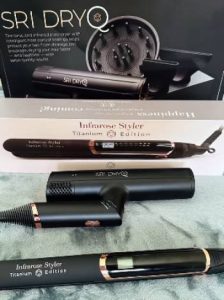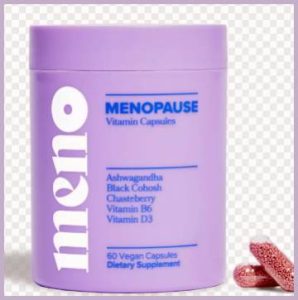If you’ve been struggling with weak, brittle, or chemically damaged hair, you’re not alone. Finding a treatment that actually repairs damage rather than just coating your strands can feel impossible. That’s where the ApHogee Two-Step Protein Treatment comes in. It’s designed to rebuild hair structure, strengthen weak strands, and stop breakage—something that countless users swear by.
But does it live up to the hype? After using it myself and analyzing real user experiences, I can confidently say that this treatment is worth considering. If your hair is feeling fragile, this might be the product that brings it back to life. Let’s break it all down.
What Is ApHogee Protein Treatment?
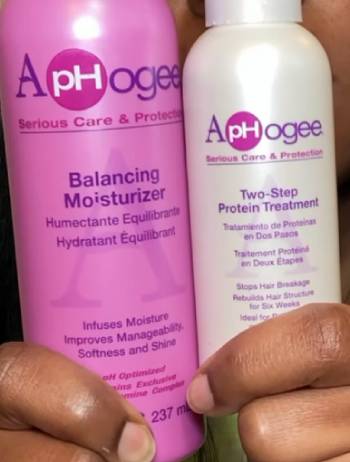
ApHogee Protein Treatment is a specialized two-step hair repair system designed to strengthen severely damaged hair caused by chemical treatments, excessive heat styling, or environmental stress. It works by infusing hydrolyzed proteins into the hair shaft, reinforcing the structure and reducing breakage. Unlike regular conditioners that primarily focus on moisture, this treatment targets the internal strength of the hair, making it an essential step for anyone experiencing significant damage, brittleness, or loss of elasticity.
The first step of the treatment involves applying a liquid protein solution that bonds to weak and compromised areas of the hair. Once the product is applied, it is dried using a blow dryer or hooded dryer, allowing the protein to harden and set into the hair. During this stage, the hair becomes stiff, which is a critical part of the process. After the treatment fully dries and bonds with the hair, it is rinsed out with warm water.
Following this, a deep moisturizing conditioner must be applied to restore balance, as protein treatments can make hair feel slightly dry. ApHogee also offers a balancing moisturizer, but any rich, hydrating conditioner can be used. This step ensures the hair remains flexible and does not become overly stiff or brittle.
Recommended for use every six to eight weeks, ApHogee Protein Treatment is particularly beneficial for those with color-treated, relaxed, permed, or bleached hair. When used correctly, it helps restore strength, maintain length retention, and prevent future breakage, making it a powerful solution for anyone looking to repair and protect their hair.
Who Needs This Treatment?
Not everyone needs an intense protein treatment like this. If your hair is in relatively good shape, a moisturizing deep conditioner might be enough. However, if you fall into any of these categories, ApHogee could be a game changer:
- Bleached or color-treated hair – Chemical processing strips protein from the hair, making it weak and prone to breakage.
- Relaxed or permed hair – Chemical treatments break down the hair’s natural bonds, and protein can help rebuild them.
- Heat-damaged hair – Frequent use of flat irons or curling wands can lead to protein loss.
- Over-moisturized hair – Yes, too much moisture can be a problem. If your hair feels mushy or overly stretchy, protein can restore balance.
- Severe breakage or shedding – If your hair is snapping off easily, it’s a sign that your strands need reinforcement.
How to Use ApHogee Protein Treatment for Best Results?
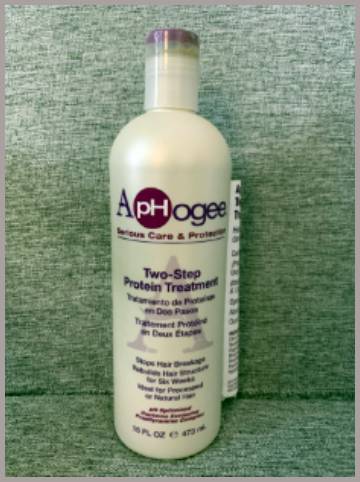
Using ApHogee Two-Step Protein Treatment correctly is crucial to achieving the best results, especially if your hair is severely damaged. Start by washing your hair with a clarifying shampoo to remove buildup, ensuring the treatment can penetrate effectively. Pat your hair with a towel to remove excess water, but leave it damp. Since the formula is liquid and can be messy, wear an old shirt and consider applying the treatment over a sink or bathtub.
Pour the solution into an applicator bottle for easier distribution, then section your hair into small parts for even application. Work from the back of your head to the front, fully saturating each section from root to tip. Avoid using clips or rubber bands, as the product will harden once dried. Once applied, use a hooded dryer or a handheld blow dryer on medium heat to dry your hair completely. Do not manipulate or touch your hair during this stage—once the treatment hardens, your hair will be stiff and should not be disturbed.
After your hair is fully dry, rinse it thoroughly with warm water until all the product is removed. Follow up immediately with a deep moisturizing conditioner or a hydrating hair mask. This step is non-negotiable, as the protein treatment strengthens the hair but can leave it feeling dry if moisture isn’t restored. Rinse the conditioner out with cool water to seal the cuticle, and style as usual. When used correctly, this process helps rebuild strength, reduce breakage, and improve hair resilience over time.
Maintenance: How to Keep Your Hair Strong After Treatment?
Maintaining strong, healthy hair after using the ApHogee Two-Step Protein Treatment requires balance between protein and moisture. Since too much protein can lead to stiffness and breakage, it’s essential to replenish hydration regularly. Deep conditioning should be a priority—use a rich, protein-free conditioner at least once a week to keep your strands soft and flexible. Look for ingredients like shea butter, aloe vera, and glycerin, which provide deep moisture without overloading your hair with additional protein.
Limit heat styling as much as possible, as excessive heat can weaken hair over time. If you must use heat, always apply a heat protectant and keep temperatures moderate. Air drying or using low-heat settings can also help maintain hair strength. Washing your hair with a gentle, sulfate-free shampoo will prevent stripping away natural oils, which are crucial for maintaining elasticity. Harsh shampoos can leave hair dry and more prone to breakage.
Space out your protein treatments—using ApHogee too often can cause protein overload, making hair feel brittle rather than strong. For most people, every six to eight weeks is enough. In between treatments, incorporate a mild protein-infused leave-in conditioner if your hair needs extra reinforcement. Regular trims are also necessary, as no treatment can fully repair split ends. Cutting off damaged ends prevents further breakage and helps hair grow healthier.
By balancing protein with moisture, minimizing heat, and using gentle hair care products, you can maintain strong, resilient strands long after your treatment.
Pros and Cons of ApHogee Protein Treatment
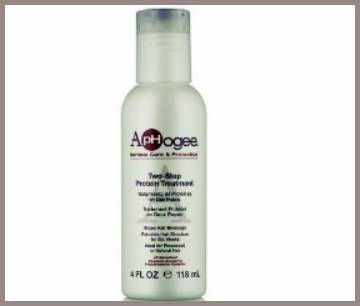
Pros:
- Repairs severe damage – Many users, myself included, have seen noticeable improvement in hair strength.
- Prevents breakage – Ideal for those experiencing excessive shedding or hair snapping off.
- Affordable and long-lasting – A single bottle can last multiple treatments, making it cost-effective.
- Restores curl pattern – If your curls have loosened due to damage, this treatment can help bring them back.
Cons:
- Strong smell – The scent isn’t pleasant, but it fades after rinsing.
- Messy application – The liquid consistency can be tricky to work with. Wearing an old t-shirt is recommended.
- Requires patience – It’s not a quick fix. You need to follow the instructions carefully for best results.
- Not for frequent use – Using this too often can lead to protein overload, making hair stiff and brittle.
Also Read: My Experience With Cleverman Hair Dye
ApHogee Vs. Other Protein Treatments
- ApHogee Vs. Olaplex No.3
ApHogee Protein Treatment and Olaplex No.3 both aim to repair damaged hair, but they work differently. ApHogee is a heavy-duty protein treatment designed for severe breakage, while Olaplex focuses on rebuilding broken bonds inside the hair shaft. ApHogee provides immediate strengthening but requires careful application and deep conditioning afterward. Olaplex is gentler and can be used more frequently without the risk of protein overload. If your hair is chemically treated and breaking, ApHogee is the better choice. If you need a more regular maintenance treatment for color damage and overall hair health, Olaplex may be more suitable.
- ApHogee Vs. Redken Extreme CAT
Redken Extreme CAT is another protein-based treatment, but it differs in intensity from ApHogee. While ApHogee works best for severely damaged hair and requires a structured process, Redken Extreme CAT is a lighter, spray-on treatment that can be used more frequently. It strengthens the hair but does not harden like ApHogee, making it less intimidating for beginners. However, if you’re dealing with major breakage or heat damage, ApHogee delivers a stronger protein boost. Redken is ideal for regular maintenance but won’t provide the same dramatic results as ApHogee.
- ApHogee Vs. Nexxus Emergencee
Nexxus Emergencee is another intensive protein treatment designed for fragile, over-processed hair. Like ApHogee, it strengthens and rebuilds the hair structure, but it is slightly more moisturizing and less harsh in application. ApHogee requires drying and hardening before rinsing, whereas Nexxus Emergencee has a smoother, more traditional conditioning process. While both are effective, ApHogee is better for extreme damage, while Nexxus is a good alternative for those who need protein without as much stiffness or mess.
- ApHogee Vs. Joico K-Pak Reconstructor
Joico K-Pak Reconstructor is a protein treatment that also contains moisturizing ingredients, making it a more balanced option compared to ApHogee. It helps repair damaged hair but does not require the same intensive drying process. ApHogee provides a deeper protein infusion, which is necessary for those with significant breakage. Joico K-Pak is a great choice for those who want to maintain healthy hair with protein while keeping it soft and manageable. However, if your hair is extremely brittle and breaking, ApHogee offers a stronger repair solution.
- ApHogee Vs. Keraphix by Nexxus
Keraphix by Nexxus is a keratin-based treatment that strengthens hair without the stiffness of ApHogee. While it helps reinforce weak strands, it doesn’t provide the same level of restructuring as ApHogee’s two-step process. ApHogee is specifically formulated for restoring hair that has suffered from chemical treatments, while Keraphix is more suitable for general strengthening and smoothing. If your hair is in critical condition, ApHogee is the better option. If you’re looking for a gentler, keratin-infused treatment to use more frequently, Keraphix is a solid choice.
Also Read: My Experience With Silicon Mix Hair Treatment
Frequently Asked Questions (FAQs)
For severely damaged hair, every 6-8 weeks is ideal. Using it too often can lead to protein overload, making hair stiff and prone to breakage.
It strengthens weak strands by bonding protein to the hair shaft. This helps reduce breakage, restore elasticity, and improve overall hair health.
No, it works for all hair types, but it’s especially beneficial for chemically processed or textured hair, which tends to lose protein more easily.
Apply it to damp, towel-dried hair for best results. This ensures even distribution without excess dripping.
Final Thoughts
If your hair is overprocessed, brittle, or breaking, ApHogee Two-Step Protein Treatment is one of the most effective solutions out there. It requires patience and proper follow-up care, but the results speak for themselves. Stronger, healthier hair is possible—you just need the right balance of protein and moisture.
Would I recommend it? Absolutely. If your hair needs serious strengthening, this treatment is a must-try. Just be sure to use it correctly, follow up with moisture, and enjoy the transformation.

